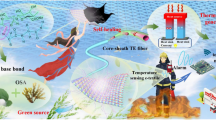Abstract
Addition-curing is the most common method for preparing high-performance silicone materials for light-emitting diode (LED) encapsulation. The structure and the hydrogen content of the hydrogen-containing cross-linking agents used in addition reactions have a significant influence on the performance of the cured products. In this study, a series of hydrogen-containing methyl phenyl silicone resins with different hydrogen content were synthesized through hydrolysis condensation. Subsequently, the high-refractive-index hydrogen-containing silicone resins reacted with vinyl methyl phenyl silicone resins to obtain methyl phenyl silicone materials. The cured products showed high light transmittance (> 89% at 450 nm), appropriate hardness and good thermal stability. The tests of reflow soldering (265°C ± 5°C for 10 cycles) and lumen depreciation (50 mA for 165 h) further demonstrated that the prepared silicone materials possessed high thermal resistance and stability. In addition, increasing the hydrogen content enhanced the cross-link density, thereby improving the thermal stability of the silicone materials. The prepared hydrogen-containing methyl phenyl silicone resins can thus serve as a cross-linker for addition-curing in high-power LED encapsulation.
Similar content being viewed by others
References
R.I. Made, Y. Gao, G.J. Syaranamual, W.A. Sasangka, L. Zhang, X.S. Nguyen, Y.Y. Tay, J.S. Herrin, C.V. Thompson, and C.L. Gan, Microelectron. Reliab. 76–77, 561 (2017).
T. Cheng, X. Luo, S. Huang, and S. Liu, Int. J. Therm. Sci. 49, 196 (2010).
X. Luo, R. Hu, S. Liu, and K. Wang, Prog. Energy Combust. Sci. 56, 1 (2016).
K.A. Bulashevich, M.S. Ramm, and S.Y. Karpov, Phys. Status Solidi 6, S804 (2009).
Z. Liu, S. Liu, K. Wang, and X. Luo, Front. Optoelectron. 2, 119 (2009).
W.F. Schroeder, E.I. dell Erba, and G.F. Arenas, Polym. Adv. Technol. 24, 430 (2013).
S.C. Yang, S.Y. Kwak, J.H. Jin, J.S. Kim, Y. Choi, K.W. Paik, and B.S. Bae, J. Mater. Chem. 22, 8874 (2012).
T. Li, J. Zhang, H. Wang, Z. Hu, Y. Yu, and A.C.S. Appl, Mater. Interfaces 5, 8968 (2013).
Y.T. Lin, Y.H. Li, I.A. Lei, C.Y. Kuo, C.F. Lee, and W.Y. Chiu, Mater. Chem. Phys. 206, 136 (2018).
I.A. Lei, D.F. Lai, T.M. Don, W.C. Chen, Y.Y. Yu, and W.Y. Chiu, Mater. Chem. Phys. 144, 41 (2014).
Z. Jiang, J. Zhang, and S. Feng, J. Appl. Polym. Sci. 104, 4144 (2007).
J. Chen, Z. Fu, X. Zeng, H. Huang, and Z. Chen, RSC Adv. 6, 71924 (2016).
X. Li, Y. Feng, X. Tan, Y. Han, and X. Sun, J. Macromol. Sci. Part A Pure Appl. Chem. 54, 690 (2017).
D.D. Li, S. Li, S. Zhang, X.W. Liu, and C.P. Wong, IEEE Trans. Compon. Packag. Manuf. Technol. 4, 190 (2014).
J.S. Kim, S.C. Yang, S.Y. Kwak, Y. Choi, K.W. Paik, and B.S. Bae, J. Mater. Chem. 22, 7954 (2012).
S. Zhao and S. Feng, J. Appl. Polym. Sci. 88, 3066 (2003).
S. Watzke and P. Altieri-Weimar, Microelectron. Reliab. 55, 733 (2015).
Z. Pan, S. Zhu, B. Huang, and L. Zhu, J. Electron. Mater. 48, 2865 (2019).
P. Singh and C.M. Tan, Opt. Mater. 86, 148 (2018).
Author information
Authors and Affiliations
Corresponding author
Additional information
Publisher's Note
Springer Nature remains neutral with regard to jurisdictional claims in published maps and institutional affiliations.
Rights and permissions
About this article
Cite this article
Pan, Z., Zeng, K., Huang, B. et al. Synthesis of Hydrogen-Containing Methyl Phenyl Silicone Resins with a High Refractive Index for LED Encapsulation. J. Electron. Mater. 49, 4816–4821 (2020). https://doi.org/10.1007/s11664-020-08199-3
Received:
Accepted:
Published:
Issue Date:
DOI: https://doi.org/10.1007/s11664-020-08199-3




